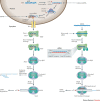Current prospects for RNA interference-based therapies
- PMID: 21499294
- PMCID: PMC7097665
- DOI: 10.1038/nrg2968
Current prospects for RNA interference-based therapies
Abstract
RNA interference (RNAi) is a powerful approach for reducing expression of endogenously expressed proteins. It is widely used for biological applications and is being harnessed to silence mRNAs encoding pathogenic proteins for therapy. Various methods - including delivering RNA oligonucleotides and expressing RNAi triggers from viral vectors - have been developed for successful RNAi in cell culture and in vivo. Recently, RNAi-based gene silencing approaches have been demonstrated in humans, and ongoing clinical trials hold promise for treating fatal disorders or providing alternatives to traditional small molecule therapies. Here we describe the broad range of approaches to achieve targeted gene silencing for therapy, discuss important considerations when developing RNAi triggers for use in humans, and review the current status of clinical trials.
Conflict of interest statement
B.L.D. serves on the Scientific Advisory Board of Marina Biotech. P.B.M. declares no competing financial interests.
Figures


Similar articles
-
An update on RNA interference-mediated gene silencing in cancer therapy.Expert Opin Biol Ther. 2014 Nov;14(11):1581-92. doi: 10.1517/14712598.2014.935334. Epub 2014 Jul 10. Expert Opin Biol Ther. 2014. PMID: 25010067 Review.
-
Running interference: prospects and obstacles to using small interfering RNAs as small molecule drugs.Annu Rev Biomed Eng. 2006;8:377-402. doi: 10.1146/annurev.bioeng.8.061505.095848. Annu Rev Biomed Eng. 2006. PMID: 16834561 Review.
-
RNA interference against viruses: strike and counterstrike.Nat Biotechnol. 2007 Dec;25(12):1435-43. doi: 10.1038/nbt1369. Nat Biotechnol. 2007. PMID: 18066040 Free PMC article. Review.
-
Vertically integrated translational studies of PDX1 as a therapeutic target for pancreatic cancer via a novel bifunctional RNAi platform.Cancer Gene Ther. 2014 Feb;21(2):48-53. doi: 10.1038/cgt.2013.84. Epub 2014 Jan 24. Cancer Gene Ther. 2014. PMID: 24457987 Review.
-
Mammalian RNAi: a practical guide.Biotechniques. 2005 Aug;39(2):215-24. doi: 10.2144/05392RV01. Biotechniques. 2005. PMID: 16116795 Review.
Cited by
-
Designed guanidinium-rich amphipathic oligocarbonate molecular transporters complex, deliver and release siRNA in cells.Proc Natl Acad Sci U S A. 2012 Aug 14;109(33):13171-6. doi: 10.1073/pnas.1211361109. Epub 2012 Jul 30. Proc Natl Acad Sci U S A. 2012. PMID: 22847412 Free PMC article.
-
A microRNA network regulates expression and biosynthesis of wild-type and DeltaF508 mutant cystic fibrosis transmembrane conductance regulator.Proc Natl Acad Sci U S A. 2012 Aug 14;109(33):13362-7. doi: 10.1073/pnas.1210906109. Epub 2012 Aug 1. Proc Natl Acad Sci U S A. 2012. PMID: 22853952 Free PMC article.
-
A Novel p19 Fusion Protein as a Delivery Agent for Short-interfering RNAs.Mol Ther Nucleic Acids. 2016 Apr 5;5(4):e303. doi: 10.1038/mtna.2016.14. Mol Ther Nucleic Acids. 2016. PMID: 27045207 Free PMC article.
-
Modulation of Gene Expression by Polymer Nanocapsule Delivery of DNA Cassettes Encoding Small RNAs.PLoS One. 2015 Jun 2;10(6):e0127986. doi: 10.1371/journal.pone.0127986. eCollection 2015. PLoS One. 2015. PMID: 26035832 Free PMC article.
-
VIRsiRNAdb: a curated database of experimentally validated viral siRNA/shRNA.Nucleic Acids Res. 2012 Jan;40(Database issue):D230-6. doi: 10.1093/nar/gkr1147. Epub 2011 Dec 1. Nucleic Acids Res. 2012. PMID: 22139916 Free PMC article.
References
-
- Kim DH, Rossi JJ. Strategies for silencing human disease using RNA interference. Nature Rev. Genet. 2007;8:173–184. - PubMed
-
- Fire A, et al. Potent and specific genetic interference by double-stranded RNA in Caenorhabditis elegans. Nature. 1998;391:806–811. - PubMed
-
- Bitko V, Musiyenko A, Shulyayeva O, Barik S. Inhibition of respiratory viruses by nasally administered siRNA. Nature Med. 2005;11:50–55. - PubMed
-
- Robbins M, et al. Misinterpreting the therapeutic effects of small interfering RNA caused by immune stimulation. Hum. Gene Ther. 2008;19:991–999. - PubMed
Publication types
MeSH terms
Grants and funding
LinkOut - more resources
Full Text Sources
Other Literature Sources
Medical

